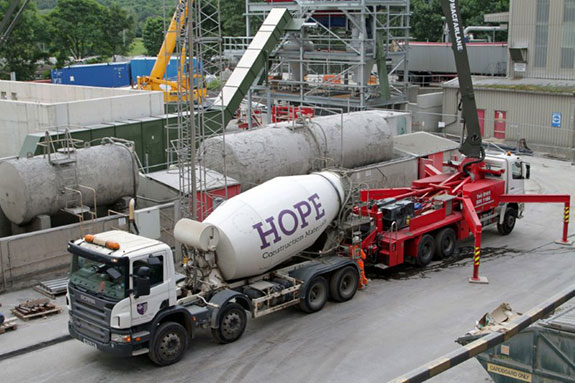WDF solutions – part 1
With a capacity of almost 1.5 million tpy, Hope Construction Materials’ facility in Derbyshire is the UK’s largest cement plant and the only active UK facility to operate twin kilns. With a heritage stretching back over 80 years, the plant has supplied cement to some of the country’s most iconic civil engineering and construction landmarks.

Hope concrete on tap during construction.
Substituting fossil fuels
Replacing fossil fuels with more sustainable waste-derived alternatives is a major part of the equation, but of course this is not new. Of the 11 cement plants operating in the UK, at least 10 operate some form of alternative fuel system to substitute a proportion of the coal that would normally be used to fire their kilns.
The Hope plant, for example, has been at the forefront of this, incorporating various waste-derived fuels for many years. Tyre chips were introduced in 2001 in the preheater tower; meat and bone meal was added to the front end of the kiln in 2006 and in 2012 a processed sewage pellet (PSP) feed system was added. Together with solid waste fuel (SWF), these have helped the plant achieve a substitution rate of around 35%.
However, the company has progressive environmental plans to increase this substitution rate to more than 50% with the introduction of a new system to handle SWF, a renewable fuel typically made up of waste material diverted from landfill. This is more easily segregated and controlled than refuse-derived fuel (RDF), which is more popular on the continent.
Challenges
Industry knowledge for optimising coal-fired cement kilns goes back years and is well understood; however, modern waste-derived alternative fuels are a whole new ball game. Burner and preheater designs may require adaptation, for example, to ensure efficient combustion, but it is the fuel handling system where the biggest challenges lie, and a clear understanding of the fuel specification and likely changes in supply is crucial.
SWF is produced by shredding and dehydrating solid waste and consists largely of combustible components of solid waste such as plastics, wood, carpet and biodegradable materials. The fuel is generally difficult to handle. It is sticky, abrasive – often containing metals and other materials – and above all non-free flowing. There is a tendency for it to bridge and build up easily, obstructing flows, which leads to downtime. It also has a high moisture content and, if left to build up or held in storage, will easily compact, sweat and even self-combust.
The Hope team first approached Saxlund International early in 2013 to design and install a fuel system for the reception, storage, transportation, weighing and injection of SWF at a rate of up to 5000 kg/hr to the two kilns at its Derbyshire site. A key requirement was to provide stable and reliable process conditions, while avoiding any material buildup in the tower, and a futureproof solution capable of handling changing fuel types.
The site location in the Derbyshire Peak District, some distance from the fuel supplier, meant onsite storage for a minimum 350 m3 of fuel was required. This would ensure at least 7 hours of fuel storage for uninterrupted operation, and greater flexibility on deliveries and fast turn-around for truck reception onsite, helping to reduce costs. At the same time, the project team needed a system with the flexibility to handle changing fuel characteristics – even different types of fuel, should suppliers change in the future.
Read part 2 here.
Written by Matt Drew, Saxlund International, UK. This is an abridged article from the January 2015 issue of World Cement. Subscribers can read the full issue by signing in. Non-subscribers can view a preview of the issue here.
Read the article online at: https://www.worldcement.com/europe-cis/08012015/wdf-solutions-part-1-81/
You might also like
The World Cement Podcast
A podcast series for professionals in the cement industry featuring short, insightful interviews. Subscribe on your favourite podcast app to start listening today.

